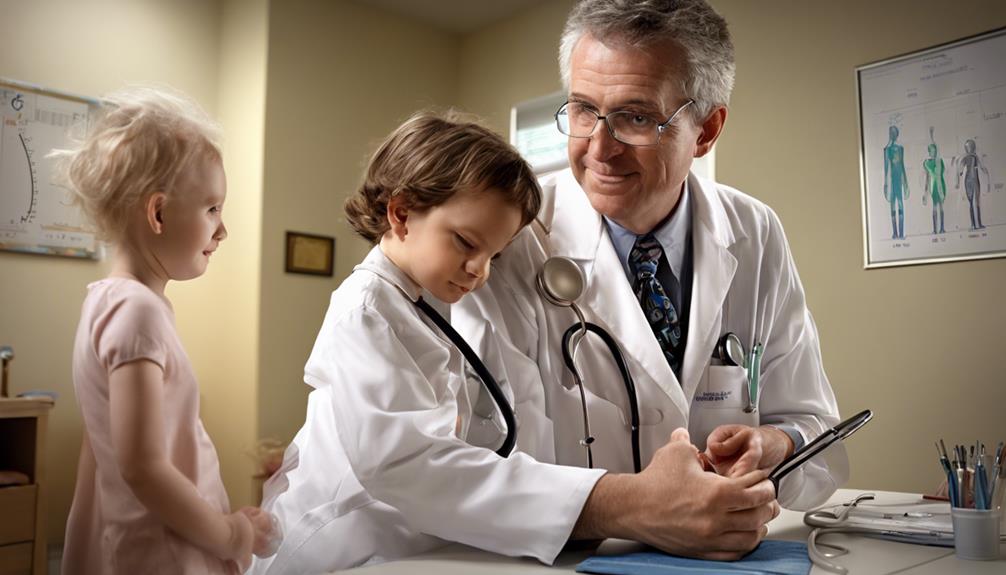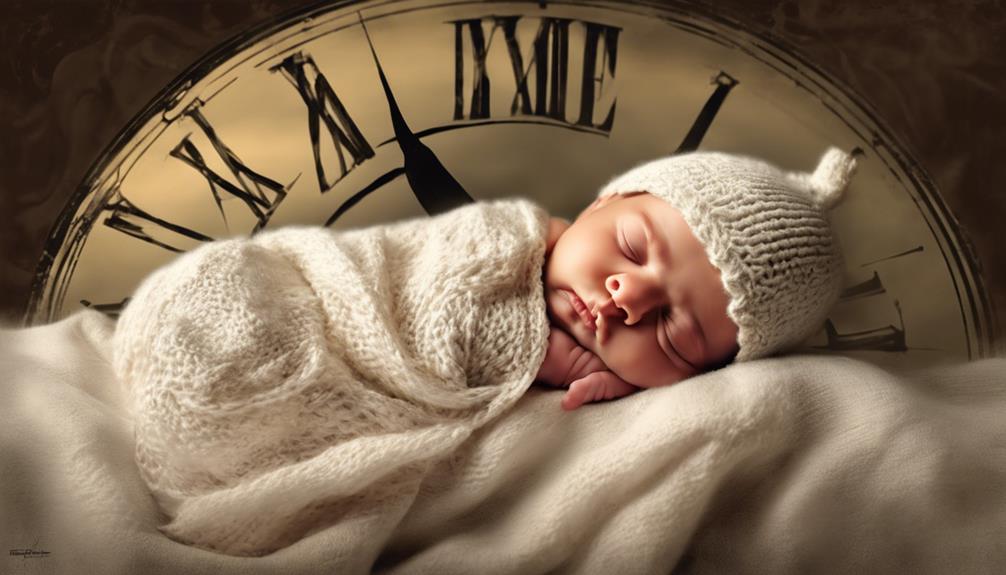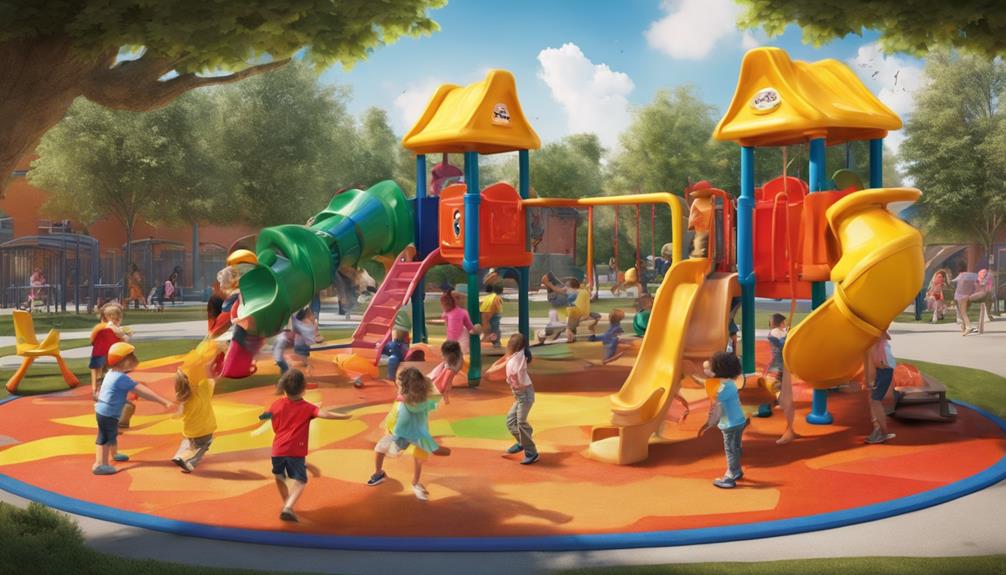As studies suggest, nearly 90% of children in the United States receive regular check-ups by the age of 2. During this critical visit, pediatricians conduct a series of 10 essential checks to make sure your child is thriving and developing as expected.
From physical measurements to developmental milestones and immunization status, each component plays an important role in monitoring your child's well-being. But what exactly are these essential checks, and why are they so important for your child's health and future growth?
Let's explore the key aspects of your child's 2-year check-up together.
Key Takeaways
- Growth tracking ensures physical development is on track.
- Developmental milestones like language progression are monitored.
- Immunizations and sensory screenings are crucial for overall health.
- Nutrition, safety, and behavior assessments support holistic child well-being.
Physical Measurements
During your child's 2-year check-up, we'll carefully measure their height, weight, and head circumference as part of a thorough physical examination to track their growth and development progress. These measurements are essential indicators of your child's overall health and well-being. By comparing these measurements to standardized growth charts, we can make certain that your child is growing at a healthy rate. Monitoring your child's weight and head circumference provides valuable insights into their nutritional status and helps us identify any potential concerns early on.
The growth chart serves as a crucial tool in evaluating your child's physical development. It allows us to track their progress over time and make informed decisions about their health. Regularly monitoring these physical measurements at each check-up enables us to verify that your child is on track to meet important developmental milestones. Rest assured that we're here to support you every step of the way in monitoring your child's growth and development.
Developmental Milestones
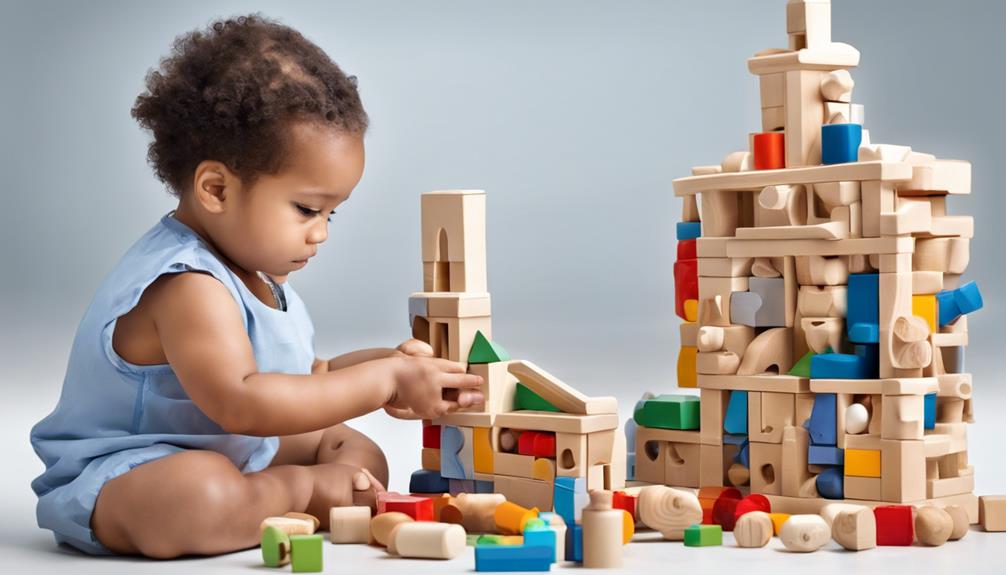
Checking developmental milestones at your child's 2-year check-up allows us to make sure they're progressing appropriately for their age. By age 2, children typically begin to show significant advancements in language development. Most children can say 50 or more words and start combining them into short phrases. They may also start identifying body parts and following simple instructions.
Additionally, 2-year-olds often display physical milestones like kicking a ball, stacking blocks, and showing increased independence in dressing and undressing. Observing these developmental milestones is essential as children of this age should be forming 2-3 word sentences and showing preferences for certain activities or toys.
Pediatricians carefully assess these milestones to track your child's progress and ensure they're meeting key developmental markers. If you have any concerns about your child's language development or their ability to perform tasks involving body parts, discussing these with your healthcare provider during the check-up is important for early intervention if needed.
Vision and Hearing Screening

At the 2-year check-up, vision screening allows us to catch potential issues like lazy eye or crossed eyes early on, ensuring prompt intervention if needed.
Hearing screening assesses a child's ability to hear sounds at various frequencies and volumes, enabling us to address any concerns promptly.
Early detection of vision or hearing problems is vital for preventing delays in speech and language development, highlighting the importance of these screenings in your child's well-being.
Vision Assessment Techniques
When evaluating a child's visual acuity during their 2-year checkup, pediatricians commonly utilize eye charts or pictures to assess their vision. This vision screening is important for detecting issues like lazy eye (amblyopia) or crossed eyes (strabismus) early on. By identifying potential vision problems at this age, timely intervention can be initiated, preventing any developmental delays and guaranteeing best visual health for the child. Pediatricians may use tools such as the Snellen chart or LEA symbols to evaluate the child's ability to recognize shapes and letters accurately.
Early detection of vision problems can prevent potential developmental delays.
Vision screening helps identify lazy eye (amblyopia) or crossed eyes (strabismus).
Timely intervention can guarantee best visual health for the child.
Using tools like the Snellen chart or LEA symbols aids in evaluating visual acuity.
Hearing Test Procedures
Evaluating a child's hearing abilities during their 2-year checkup involves simple procedures that aim to detect any potential hearing issues early on, contributing to their overall speech and language development. Hearing tests are important during this checkup as they help in the early detection of any problems that could impact a child's communication skills.
These tests can include activities where the child listens to sounds or responds to cues, allowing pediatricians to assess their hearing abilities accurately. By identifying hearing issues early, interventions can be initiated promptly, preventing any delays in speech and language development.
Ensuring that these screenings are part of the 2-year checkup is essential for monitoring a child's overall health and well-being.
Follow-Up Recommendations
For optimal developmental progress and overall well-being, ensuring timely follow-up recommendations for vision and hearing screening after the 2-year check-up is essential. Early detection plays an important role in addressing any potential vision or hearing issues that may arise in your child.
Here are some emotional considerations to keep in mind:
- Detecting vision problems early can prevent potential learning challenges.
- Identifying hearing issues promptly can enhance your child's communication skills.
- Addressing vision or hearing concerns swiftly may improve your child's quality of life.
- Regular screenings demonstrate your commitment to your child's well-being, setting a foundation for their future success.
Immunization Status
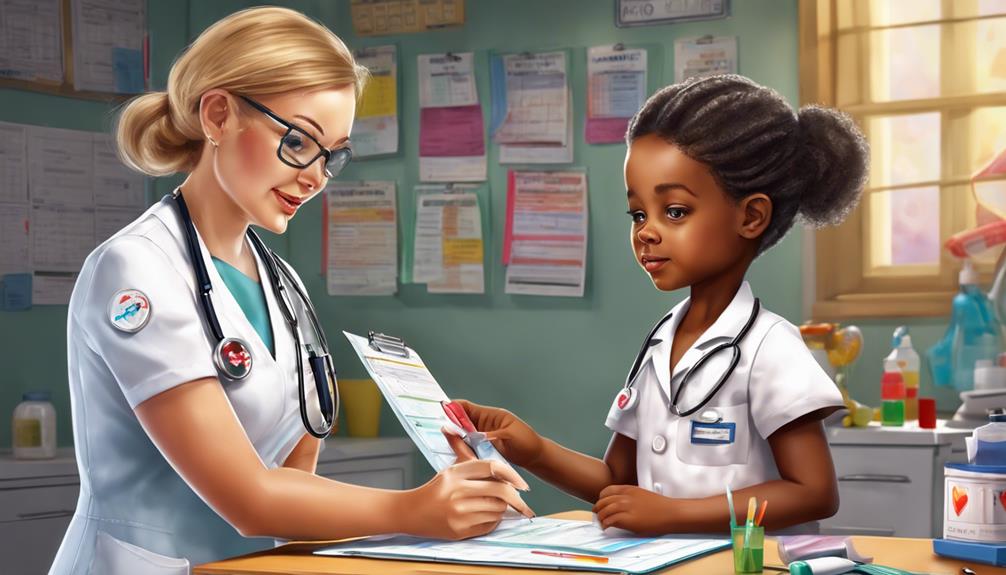
Ensuring your child's immunization status is up-to-date is essential for protecting their health and building their overall immunity by age 2. By this time, most children should have received key childhood immunizations like DTaP, IPV, MMR, and varicella (chickenpox). These vaccines shield your child from serious illnesses and lay the foundation for a robust immune system.
At the 2-year check-up, it's vital to review their immunization records to confirm they're current on all recommended vaccines. If any shots were missed, such as hepatitis B or DTaP, this is the perfect opportunity to catch up. Additionally, depending on your child's medical history and local recommendations, they may be due for vaccines like hepatitis A, influenza, or even COVID-19.
Staying vigilant about your child's immunization status not only safeguards their well-being but also contributes to the overall health of the community by preventing the spread of infectious diseases.
Nutrition and Feeding Habits

Reviewing your child's nutrition and feeding habits is a key aspect of their overall health and development as they reach their 2-year check-up. It's vital to encourage healthy food choices and guarantee proper meal frequency to support their growth and development.
As parents, we can play an important role in guiding them towards balanced nutrition by discussing serving sizes and addressing any picky eating habits they may have. Additionally, raising awareness about choking hazards and promoting safe eating practices for toddlers is paramount to their well-being.
- Encourage Healthy Choices: Support your child's development by offering nutritious foods.
- Address Picky Eating: Help them explore new foods and make sure they receive the necessary nutrients.
- Promote Safe Eating Practices: Be mindful of choking hazards and establish good eating habits early on.
- Limit Sugary Intake: Avoid foods high in sugar, salt, and fat, and opt for healthier snack options.
Speech and Language Development
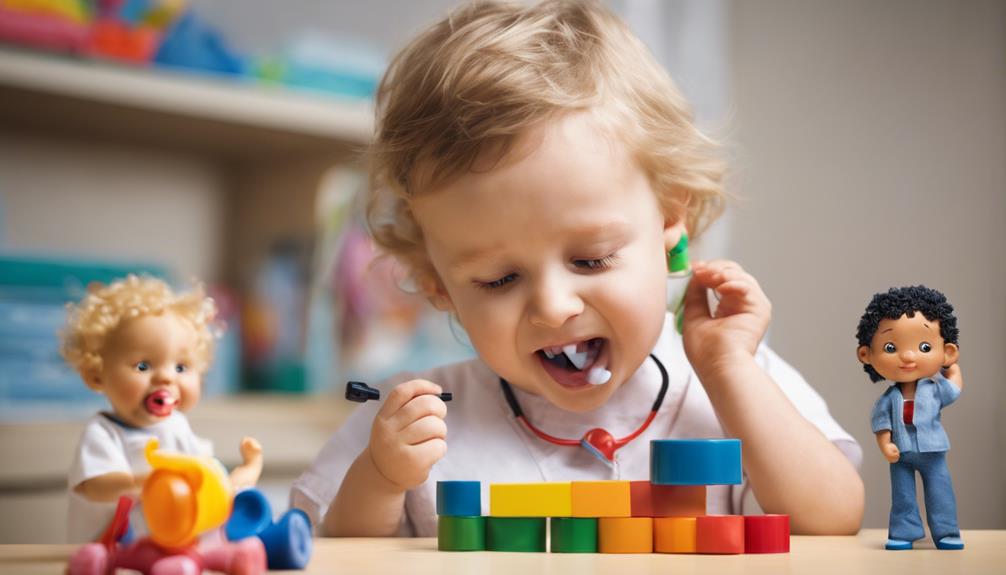
When we talk about a child's speech and language development at the 2-year check-up, we focus on important aspects like vocabulary growth, pronunciation clarity, and communication skills. Pediatricians will observe how well the child can name familiar objects, show an understanding of basic instructions, and engage in simple conversations.
Evaluating these milestones helps in understanding the child's progress and identifying any areas that may need further support.
Vocabulary Growth Milestones
As children approach their 2-year check-up, it's important to understand the significant vocabulary growth milestones in their speech and language development. By this age, most toddlers can say around 50 words and grasp the meaning of up to 200 words. They should begin combining words to form simple sentences and may start asking basic questions. Expressive vocabulary tends to expand quickly between 18-24 months, showing their growing ability to communicate.
It's heartwarming to witness their speech development, as they work on pronouncing vowels and some consonants clearly, paving the way for more crucial language skills. Encouraging this growth is essential for their overall development and building a strong foundation for future communication.
- Witnessing their first sentences form is truly magical
- Seeing them understand new words is a joyous experience
- Their curiosity in asking questions is both delightful and encouraging
- Each new word spoken is like a small victory
Pronunciation Clarity Assessment
Upon observing a child's vocabulary growth milestones, the next step involves evaluating their pronunciation clarity as part of their speech and language development progress. This evaluation focuses on how well your child can pronounce words clearly and express themselves verbally. It includes tasks like naming common objects and body parts. Evaluating your child's language skills at this age is vital for identifying any potential speech delays early on. By ensuring your child can form basic sentences, use simple phrases, and follow instructions, you support their overall communication development. Here is a table summarizing key points in the pronunciation clarity evaluation:
| Evaluation Area | Description | Importance |
|---|---|---|
| Pronunciation | Evaluate how clearly words are pronounced | Essential for communication skills |
| Sentence Formation | Ability to form basic sentences | Indicates language development |
| Verbal Expression | How well the child can express themselves | Shows progress in communication |
Communication Skills Evaluation
Have you noticed how well your child communicates and expresses themselves verbally?
At the 2-year check-up, the pediatrician will evaluate your child's speech and language development milestones. This assessment includes observing vocabulary, sentence formation, and communication skills.
The doctor will also assess how well your child understands and responds to instructions and questions. Additionally, screening will be conducted to check for any potential speech delays or language disorders.
It's crucial to address any concerns early to provide guidance and support for enhancing your child's communication abilities.
Behavioral and Social Skills

During your child's 2-year check-up, we focus on evaluating their language development, social interactions, and emotional regulation skills. We pay close attention to how they engage with others, looking for positive signs of social interactions like sharing, taking turns, and following simple instructions. By observing their play patterns and interactions with peers, we gain insight into their social development and ability to engage in imaginative play.
If there are concerns about tantrums, separation anxiety, or other behavioral challenges, we're here to discuss them with you. We provide guidance on positive reinforcement techniques to encourage healthy social and emotional growth. By addressing these aspects of your child's development early on, we can work together to support their behavioral and social skills, setting a strong foundation for their future interactions and relationships.
Safety and Injury Prevention
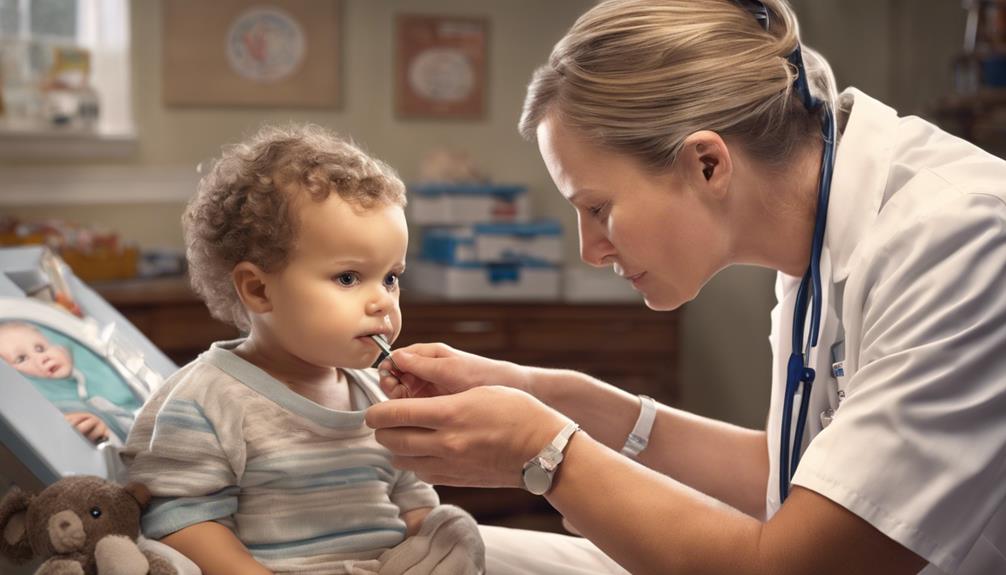
As we guide parents through evaluating their child's social and behavioral skills, we now shift our focus to discussing important safety measures and injury prevention strategies. Ensuring child safety is paramount both at home and outdoors, and taking proactive steps can greatly reduce the risk of accidents.
- Secure Home Environment: Childproofing your home is essential to prevent accidents such as falls and ingesting harmful substances.
- Supervision and Guidance: Providing constant supervision and guidance can help avoid potential dangers and guarantee a safe environment for your child.
- Car Seat Safety: Properly securing your child in a car seat and following transportation precautions are crucial to prevent injuries in case of an accident.
- Playground Equipment Safety: Checking the safety of playground equipment and encouraging safe play can minimize the risk of injuries during active playtime.
Growth Chart Evaluation
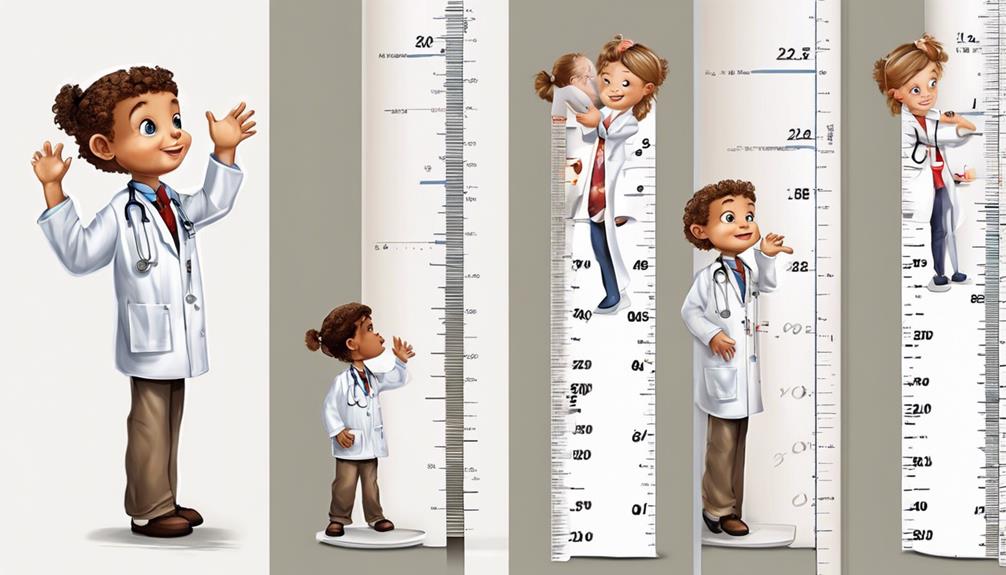
When we evaluate a child's growth chart, we focus on three key points: height and weight, developmental milestones, and overall growth trend.
By tracking these indicators, we can monitor your child's growth progress and identify any potential concerns early on.
Comparing these measurements to established growth percentiles helps us assess your child's growth patterns and overall health status.
Height and Weight
Measuring your child's height and weight at the 2-year check-up is essential for accurately tracking their growth progress and ensuring they're developing healthily. When we plot these measurements on a growth chart, we can compare your child's growth with established norms, helping us identify any concerns that may need further investigation. Monitoring these trends over time is vital for confirming your child's overall health and development. It allows us, as pediatricians, to evaluate that your child is growing at a healthy rate for their age and gender.
Remember, these evaluations aren't just numbers; they represent your child's journey towards a happy and healthy future.
- Tracking growth progress accurately
- Identifying potential concerns early
- Confirming healthy development
- Providing personalized care and support
Developmental Milestones
Understanding your child's developmental milestones through growth chart evaluation provides valuable insights into their progress in various areas of development at the 2-year check-up. During this evaluation, the pediatrician will assess language development, social skills, cognitive abilities, and motor skills like stacking blocks.
The growth chart helps track your child's height, weight, and head circumference, giving a detailed view of their physical growth. Questions about your child's ability to identify body parts, form basic sentences, and show independence in tasks like dressing and undressing will be asked.
Overall Growth Trend
Evaluating a child's overall growth trend at the 2-year check-up involves assessing their height, weight, and head circumference to track developmental progress and make sure milestones are being met. This assessment helps us understand the child's body mass index, growth patterns, and physical development.
Here are some key points to contemplate during the growth chart evaluation:
- Witnessing your child's growth on the chart can evoke feelings of pride and reassurance.
- Identifying any deviations from the expected curve may spark concern, but early intervention can help.
- Discussing nutrition and health habits can foster a sense of empowerment in ensuring your child's well-being.
- Monitoring the growth chart provides a tangible representation of your child's journey and accomplishments, creating a deeper connection to their development.
Parental Concerns and Questions

During the 2-year check-up, parents often express concerns and ask questions about their child's behavior, milestones, and development. It's natural for caregivers to seek reassurance and guidance on various aspects of their child's well-being. Addressing feeding and nutrition issues such as picky eating, meal frequency, and appropriate serving sizes is vital for ensuring proper growth and development. Safety inquiries about home, outdoor environments, car seat usage, and playground safety are also common topics that parents bring up during this check-up. Additionally, questions regarding sleep routines, bedtime habits, and shifting from a crib to a bed are typical concerns that parents may have. Dental health is another area where parents seek advice, including discussions on fluoride varnish application and dental care practices.
| Parental Concerns | Examples | Discussion |
|---|---|---|
| Child's Behavior | Tantrums, social interactions | Address behavior management strategies |
| Feeding & Nutrition | Picky eating, serving sizes | Provide guidance on healthy eating habits |
| Safety Inquiries | Home safety, car seat usage | Offer tips for creating safe environments |
Frequently Asked Questions
What Do They Do at 2 Year Check Up?
At the 2-year check-up, we measure height, weight, and head circumference to monitor growth. Screenings for conditions like lead exposure are conducted. Developmental milestones are observed, and discussions on nutrition and sleep occur to address concerns.
Do They Draw Blood at 2 Year Check Up?
Yes, they draw blood at a 2-year check-up. It's a routine part of evaluating your child's health. The process is quick and helps screen for conditions like anemia. It's essential for monitoring overall well-being and addressing any health concerns.
What Questions Should I Ask My 2 Year Old for a Check Up?
When we visit the doctor for our little one's check-up, we ask about their language skills, behavior changes, motor abilities, body part recognition, and independence. These conversations help us understand their development and well-being.
What Is a 2 Year Old Assessment?
At 2 years old, an assessment involves measuring height, weight, head circumference, and screenings for various health conditions. Dental checks, developmental milestones evaluation, and specific autism risk screenings are conducted to guarantee holistic well-being.
Conclusion
As parents, we grasp the importance of staying informed and proactive about our child's health.
Did you know that by age 2, a child's brain is already 80% of its adult size? This highlights the critical period of growth and development that occurs during these early years.
By attending regular check-ups and addressing any concerns promptly, we can guarantee our little ones have the best start in life.
Take advantage of these opportunities to support your child's well-being and future success.
